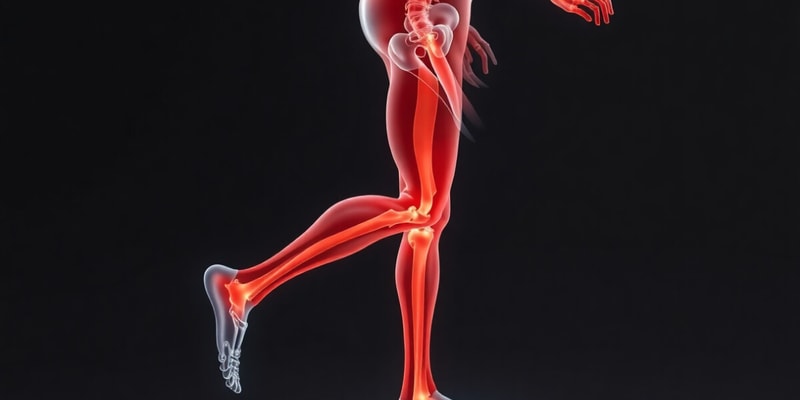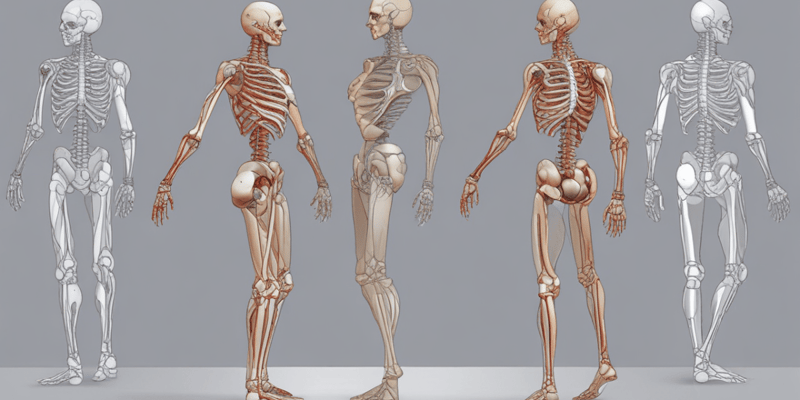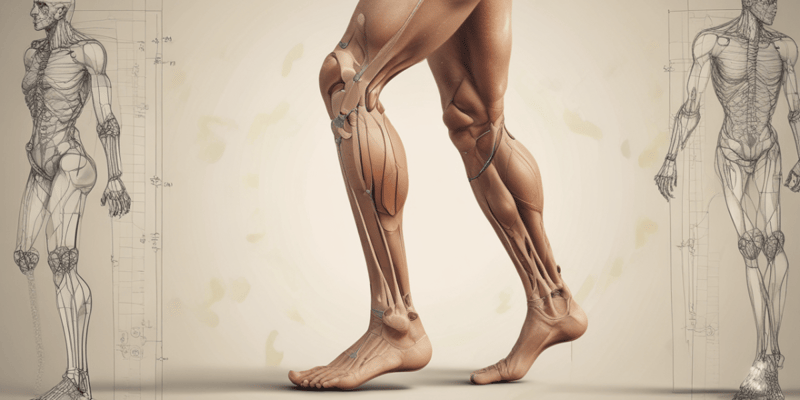Podcast Beta
Questions and Answers
What is the Preferred Transition Speed (PTS) at which most people spontaneously transition from walking to running?
Which of the following changes occurs in Ground Reaction Force (GRF) during walking at increasing speeds?
What muscle activation change is required in walking compared to running as locomotion speeds increase?
What might trigger the transition from walking to running?
Signup and view all the answers
What type of mechanics were studied by Neptune and Sasaki in 2005 regarding the transition to running?
Signup and view all the answers
What occurs to the Ground Reaction Force during the loading phase of walking at increased speeds?
Signup and view all the answers
Which factor is primarily highlighted in the relationship between joint kinetics and gait transition?
Signup and view all the answers
Which aspect of running mechanics is associated with the control of leg stiffness?
Signup and view all the answers
What is a key factor influencing the switching between coordination patterns in movement?
Signup and view all the answers
Which type of model predicts that coordinated movement can occur without descending control from the brain?
Signup and view all the answers
In the context of movement control, what is most likely to regulate the modulation of lower reflexes?
Signup and view all the answers
What recent development integrates ideas from both hierarchical and dynamical system models of movement control?
Signup and view all the answers
What does switching between stable and unstable patterns of limb dynamics indicate?
Signup and view all the answers
What effect does increased walking speed have on plantarflexor force production?
Signup and view all the answers
In the transition from walking to running, which of the following changes occurs?
Signup and view all the answers
How can running mechanics be characterized in terms of phases?
Signup and view all the answers
What contributes primarily to the vertical displacement of the center of mass (CoM) during running?
Signup and view all the answers
What occurs when the foot makes contact in front of the center of mass (CoM)?
Signup and view all the answers
Which of the following correctly describes the spring-mass model of running?
Signup and view all the answers
Which factor is least likely to increase while running compared to walking?
Signup and view all the answers
What is indicated by the formula $K = \frac{F_g}{y}$ in regard to leg stiffness?
Signup and view all the answers
What is the primary objective of optimizing leg compression during sprinting?
Signup and view all the answers
What change in mechanical situation occurs for plantarflexors during running compared to high walking speeds?
Signup and view all the answers
Which factor does NOT influence leg stiffness during sprinting?
Signup and view all the answers
In terms of joint flexion, what difference is observed between running and walking?
Signup and view all the answers
In sprint mechanics, increasing which of the following can lead to improved speed?
Signup and view all the answers
What effect does increased leg stiffness have on force absorption during sprinting?
Signup and view all the answers
Which of the following is a disadvantage of increasing leg stiffness?
Signup and view all the answers
What is the relationship between stride frequency and sprinting speed?
Signup and view all the answers
What is the primary biomechanical goal of minimizing landing distance in sprinting?
Signup and view all the answers
How does the configuration of the leg during sprinting affect performance?
Signup and view all the answers
What role do connective tissues play in regulating leg stiffness?
Signup and view all the answers
Which of the following factors would NOT encourage faster sprinting?
Signup and view all the answers
What role does arm movement play in the dynamics of running?
Signup and view all the answers
Which of the following statements correctly describes leg stiffness in running?
Signup and view all the answers
In dynamics systems theory, what is the significance of 'attractor' states?
Signup and view all the answers
What is a potential impact of reduced dimensionality in the motor system according to dynamical systems theory?
Signup and view all the answers
What is the purpose of limiting braking force in running mechanics?
Signup and view all the answers
How does the dynamical systems model view movement variability?
Signup and view all the answers
What distinguishes sprint running from distance running in terms of biomechanical reliance?
Signup and view all the answers
What is indicated by the coordination patterns that are more 'stable' than others in the dynamical systems model?
Signup and view all the answers
Which statement best reflects how the dynamical systems model predicts movement?
Signup and view all the answers
What does the term 'self-organising' indicate in the context of human movement?
Signup and view all the answers
Study Notes
The Walk-to-Run Transition
- The preferred transition speed (PTS) from walking to running is approximately 2 m/s or 7.2 km/h for most people.
- The PTS does not occur at a speed where the energetic cost of walking becomes greater than running.
- As walking speed increases, the ground reaction force (GRF) during the loading phase increases, while GRF during the pre-swing/propulsion phase decreases.
- Increased walking speed also leads to greater posterior GRF during the loading phase and greater anterior GRF during the propulsion phase, up to a certain point.
Joint Kinetics and Gait Transition
- Walking requires greater plantarflexion torque than running across various locomotion speeds.
- Walking at speeds above the PTS requires greater ankle dorsiflexion, knee flexion, and hip extension during the swing phase.
- The increased effort required to activate muscles around the ankle, hip, and knee could potentially trigger the transition to running.
Muscle Mechanics in Gait Transition
- Increasing walking speed leads to increased muscle activation in all muscles, but also increased deviation from optimal length and shortening velocity in plantarflexors.
- This results in a decrease in plantarflexor force despite increased muscle activation.
- Transitioning to running leads to slightly increased activation in plantarflexors and dorsiflexors, resulting in slightly increased dorsiflexor force output and at least double the plantarflexor force output.
- This suggests that muscle mechanics make plantarflexor force production more difficult at high walking speeds, while running improves the mechanical situation for plantarflexors.
Running Mechanics
- The running cycle consists of a stance phase and an airborne phase.
- Stride length (SL) in running is comprised of take-off distance, flight distance, and landing distance.
- Stride rate (SR) in running is determined by time in contact with the ground and time in air.
- Running, compared to walking, features an airborne phase, increased joint flexion, higher energy expenditure, and increased SL and SR.
Force Application During Running
- Foot contact in front of the center of mass (CoM) during running produces a horizontal force opposing the direction of motion, acting as a braking force.
- Modifying foot placement and actively extending the hip reduces this braking force.
- Removing this braking force through altered foot placement and active hip extension increases CoM velocity.
Running and Leg Stiffness
- Running can be modeled as a spring-mass system, where leg stiffness is crucial.
- Leg stiffness is determined by the magnitude of joint torques, muscle forces, muscle activity, stiffness of elastic soft tissues (muscle, tendon, connective tissue), and leg configuration.
- High leg stiffness allows rapid opposition to ground reaction forces, minimized force absorption, and shortened stance phase but increases vertical CoM displacement.
Regulating Leg Stiffness
- Leg stiffness is affected by joint torques, muscle forces, muscle activity, stiffness of elastic soft tissues, and leg configuration.
- Greater GRF moments (torques) at each joint require greater muscle force to counteract, impacting leg stiffness.
Sprint Mechanics
- The goal of sprinting is to cover a given distance in the shortest possible time.
- Sprinting involves increased stride frequency, reduced time on the ground, increased leg stiffness, reduced rate of joint rotation, increased stride length, increased flight distance, and increased speed of release (take off).
Muscle Force Considerations During Sprinting
- Leg swing creates a torque around the longitudinal body axis.
- Movement of the opposite arm counteracts this torque, preventing trunk rotation and mediolateral force generation.
Main Points (Running Mechanics)
- Limiting braking force through proper foot strike and muscle activation is crucial for running efficiency.
- High, but not maximal, leg stiffness is essential for running economy, determined by elastic elements, muscle activation, and joint configuration.
- Sprinting and distance running differ in their reliance on passive forces, with distance running relying more on passive forces.
Dynamical Systems Theory
- The motor system reduces its biomechanical degrees of freedom through the development of coordinative structures or temporary assemblages of muscle complexes.
- This reduction in complexity leads to the development of functionally preferred coordination patterns or "attractor" states.
- Within each attractor region, system dynamics are stable and ordered, resulting in consistent movement patterns.
- Transitions between attractor regions allow for flexible and adaptive motor system behavior and exploration.
Dynamical Systems Model
- The model views human movement as self-organizing, based on limb dynamics.
- It predicts that more stable coordination patterns exist, towards which the system gravitates.
- Movement can emerge without specific motor commands from higher centers.
- Specific "control variables" dictate transitions between coordination patterns.
Stable Coordination Patterns
- The brain may have stable and unstable patterns of activity, interacting with limb dynamics to produce stable movement.
- Switching between coordination patterns can be voluntary or driven by changes in a "control variable."
Main Points (Models of Movement Control)
- Hierarchical models emphasize the role of the brain in specifying muscle and movement commands.
- Dynamical systems models highlight the mechanics of the human musculoskeletal system and predict that coordinated movement can occur without descending control.
Studying That Suits You
Use AI to generate personalized quizzes and flashcards to suit your learning preferences.
Related Documents
Description
Explore the biomechanical principles behind the walk-to-run transition. This quiz examines the preferred transition speed, joint kinetics, and the role of muscle mechanics in gait dynamics. Test your knowledge on how these factors influence locomotion and the energetic costs associated with walking and running.



